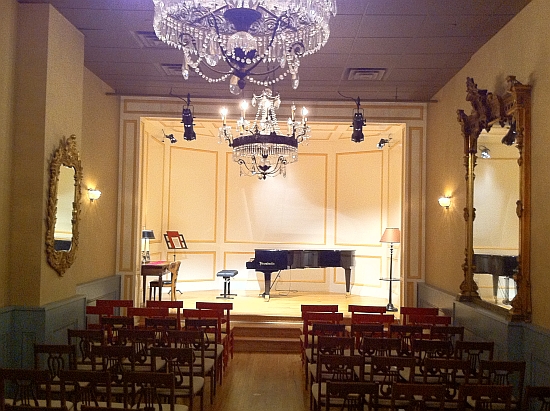 United States Beethoven, Schubert: Montreal Chamber Music Festival, Denis Brott (cellist), Kevin Louks (piano), Afiara Quartet, WMP Concert Hall, New York, 20.1.2012 (SSM)
United States Beethoven, Schubert: Montreal Chamber Music Festival, Denis Brott (cellist), Kevin Louks (piano), Afiara Quartet, WMP Concert Hall, New York, 20.1.2012 (SSM)
Beethoven: Sonata for Cello and Piano in A Major, Op.69
Schubert: Quintet in C Major, D. 163, Op. Posth. 163

The venue for last night’s concert, the WMP Concert Hall, is adjacent to a repair shop for rare violins. The old-world look of their shared storefront seems out of place on a block that has over the years held hardware stores, bodegas and illegal phone stores that would unlock a cell phone for a price. Passing the storefront on my way to the subway, I was drawn to the concert schedule taped to a window above an array of instruments. Inside, what was once a commercial lobby is now a salon with chandeliers, gilded mirrors, seventy chairs and a wooden shell that holds a concert grand Bösendorfer. (It’s nice to hear a piano in concert these days other than a Steinway.) In addition to raising the performers and instruments to a more visible level, the shell was also designed to improve acoustics. If there was anything less than perfect in this performance it was that the players did not compensate for the smaller acoustical space. Particularly in the Schubert, the five musicians almost sounded like an orchestra.
But what an orchestra! Every note played to perfection, brimming with emotion, and a performance of Schubert’s Adagio that made me feel this has to be the saddest, most doleful music ever written, almost too painful to hear. I had forgotten how ravishing a work this is. Having terminally scratched my old Columbia Masterworks LP performance with Isaac Stern and Pablo Casals and torn to shreds the green cover with use, I knew every single note but also realized last night how I was familiar with just this one particular performance, recorded at the Prades Festival in 1954. I’ve heard the Quintet played over the years, but this was the first time I truly listened to it since I was a teenager.

The moments of sheer transcendent beauty abounded from both the music and the musicians. The brief and soft introductory motif, played once by the violinist and repeated by the cello, leads with only a measure or two of notice into an agitated first theme with the cello continuing obliviously to play the opening motif. The second theme takes advantage of the second cello to play along with the first in a haunting duet.
The development section of this first movement shows Schubert using dissonance that would rarely be heard again until the end of the century. Chords shriek as if in pain. After several hesitant repetitions of the opening theme convinced the listener that each iteration is the beginning of the recapitulation, it does finally come back, leading to the movement’s two ominous final chords, one ff and the other marked p.
The Adagio consists of the simplest group, two dotted figures and a slur with a grace note. Schubert knew how to squeeze from this phrase every possible melodic and harmonic element. First violinist Yuri Cho played as if the music was playing her, so possessed did she seem with Schubert’s spirit. A performance like this adds credence to the view that Schubert knew his life was nearing its end, that this last great masterpiece written the year he died would be one to define his legacy.
  F.Mendelssohn, F.Schubert, Octet op. 20, SQ4t op.13 F.Mendelssohn, F.Schubert, Octet op. 20, SQ4t op.13Afiara (+Alexander String Quartet) Foghorn Music     |
The bouncy third movement leads the listener to think that here at least is music that is not crying de profundis. Strongly accented double-stops and long runs of quavers in the light-colored key of C Major fool us into believing all is well until the trio brings us back into the world of the Adagio. The scherzo form, based on the older minuet, always has as its contrasting central section a trio. Traditionally, it is a light-hearted often rustic dance, but not here where it vies with the Andante Con Poco Mosso from the B-flat Trio, Op.99, as to which is more heart-rending.
Whether the final movement is upbeat or a wild Totentanz is debatable. Both the Casals recording and the performance by the Afiara Quartet treat it successfully as high drama. The intensity of the Afiara’s playing was palpable, and I found the lead-in to the coda and the coda itself enthralling.
None of the above should take away from the exceptional opening performance by cellist Denis Brott and pianist Kevin Louks of Beethoven’s Sonata for Cello and Piano, Op. 69. With the exception of one brief moment where the naturally big-sounding Bösendorfer overpowered the cellist, the players were in perfect accord.
Mr. Brott prefaced the work with a reading of Beethoven’s “Immortal Beloved” letter. Half the letter was recited before the first movement and the other half before the third. Sensitive to every nuance, both players demonstrated the emotional connection of the Sonata to Beethoven’s state of mind at the time.
It wasn’t just the technical prowess that made the evening so special. Virtuosity is simply a given – commitment of one’s entire being to the music is not.
Stan Metzger
The program performed here was a preview of the 17th Annual Montreal Chamber Music Festival to be held in Montreal from May 10th to June 2, 2012. For information see Quebec Getaways. The Web site for the Montreal Chamber Festival has not yet been updated for 2012.
